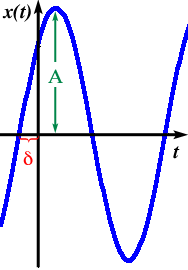Initial Conditions and Phase
 We
have earlier encountered the equation of motion for simple harmonic motion as a cosine function. This actually is only true for the special case that the object undergoing simple harmonic motion is at maximum positive displacement at time t = 0. The general expression for SHM is
We
have earlier encountered the equation of motion for simple harmonic motion as a cosine function. This actually is only true for the special case that the object undergoing simple harmonic motion is at maximum positive displacement at time t = 0. The general expression for SHM is
x(t) = A sin($\omega$t+$\delta$)
where x(t) is the displacement, $\omega$ is
the frequency, and $\delta$ is the phase. The
units of phase have to be the same as that of $\omega$t
(radians or degrees.) In the figure on the right, you can see what
the constants A and $\delta$ mean
graphically.
Equations of motion containing sine and cosine expressions are the
same except for the phase. In problems dealing with SHM, the phase is
determined by the initial conditions.
A simplification that has been used throughout most of this
chapter has been to choose the form
x(t) = A cos($\omega$t)
for cases where the displacement is at a maximum at t = 0. However, this is included as a special case of the general equation above, fixing the phase $\delta$ to a value of
$\pi$/2. One can understand this fact from the
simple trigonometric identity
sin($\omega$t+$\pi$/2)
= cos($\omega$t)
You could also select an initial condition where the equation of
motion would be
x(t) = A sin($\omega$t)
by choosing a phase of $\delta$ = 0. This could be done by giving the oscillator initially zero displacement but some nonzero value for the velocity.
© MultiMedia Physics,
1999/2000
 We
have earlier encountered the equation of motion for simple harmonic motion as a cosine function. This actually is only true for the special case that the object undergoing simple harmonic motion is at maximum positive displacement at time t = 0. The general expression for SHM is
We
have earlier encountered the equation of motion for simple harmonic motion as a cosine function. This actually is only true for the special case that the object undergoing simple harmonic motion is at maximum positive displacement at time t = 0. The general expression for SHM is